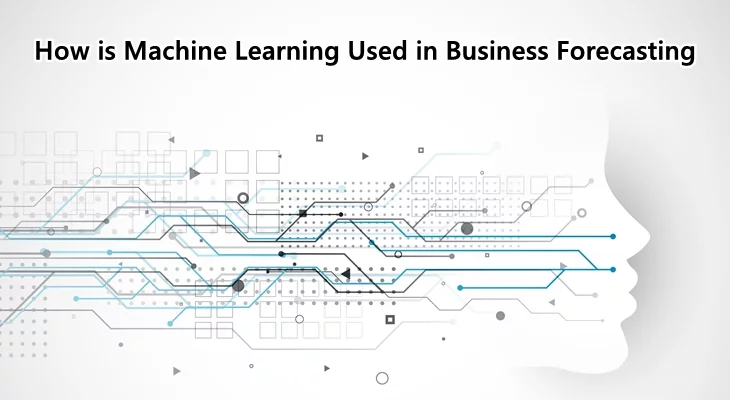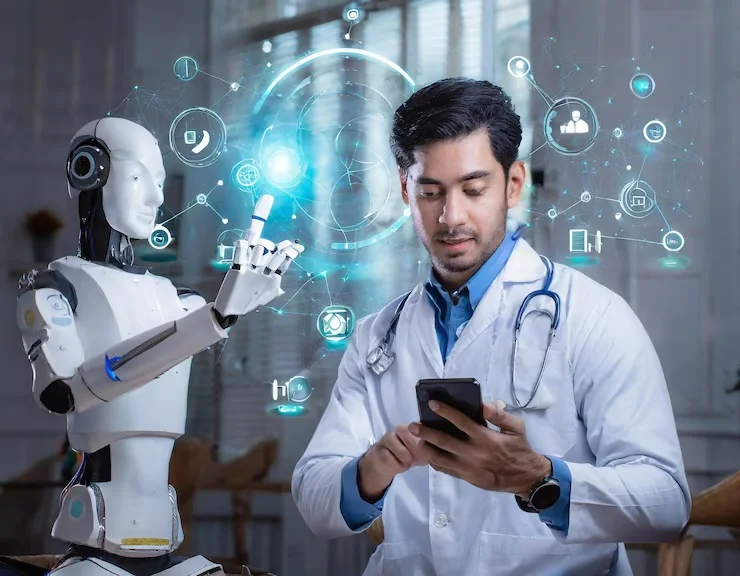What is Machine Learning?
Machine learning is one of the branches of artificial intelligence (AI). Machine Learning allows computers to learn and improve on their own. This eliminates the need for machines to be programmed. Machine learning creates computer programmes that access data and learn on their own. Machine Learning is used in Business Forecasting to increase the efficiency of the business.
The learning process starts with observations and data. Such as examples, direct experience, or instructions. These are provided so that the machine can seek patterns in data and make better decisions in the future. The fundamental goal is for computers to learn on their own. It aims to eliminate the need for human involvement and to change their behavior accordingly.
The text is treated as a series of keywords in machine learning algorithms. Instead, a semantic analysis technique mimics the human ability to comprehend the meaning of a document.
How Does Machine Learning Work?
A Prediction or Classification Process:
Machine learning algorithms create predictions or classifications in general. Your algorithm will generate an estimate of a pattern in the data. This is done based on some input data, which is then labeled or unlabeled.
An Error Function:
An error function assesses the model's prediction. If there are any known examples, an error function can be used to compare the model's accuracy.
Weights are modified to lessen the difference between the known example and the model estimate. This is done if the model can fit better to the data points in the training set. This evaluate and optimize procedure will be repeated by the algorithm. It will update weights on its own until a certain level of accuracy is achieved.
What is Business Forecasting?
The system followed to forecast business events is called Business Forecasting. These events can be sales, expenditures, and profits. Business forecasting is used to generate better strategies based on these accurate predictions. Past data is gathered and evaluated using quantitative or qualitative models. This data can be used to identify trends. These trends can then be used to guide business tasks. These tasks can be demand planning, financial operations, future production, and marketing operations.
The business forecasting process is as follows:
• Identify the problem, data point, or question that will be the basis of the systematic study.
• Determine the best method for gathering datasets by identifying relevant theoretical variables.
• Based on the information gathered, make predictions about future business activities.
• Select the best model for the dataset, variables, and estimates. The chosen model analyses the data and makes a prediction.
• Take note of the differences between actual and predicted performance. Use this data to increase the accuracy of future forecasts by refining the prediction process.
Machine Learning Techniques for Demand Forecasting
Demand forecasting is the estimation of a product's or service's likely future demand. Demand Planning and Forecasting are terms used interchangeably. Demand planning is a broader process. It begins with forecasting but is not restricted to it.
Many additional tasks, including warehousing, shipping, price forecasting, supply planning come under forecasting. These tasks require data on customers' projected needs, which starts with demand planning.
Following are two techniques of Demand Forecasting with Machine Learning
Predictive sales analytics: Modeling for the Future
Predictive analytics is a popular enterprise use of machine learning. It is combined with statistical methodologies. It enables not just the estimation of demand but also the comprehension of what drives sales. It also gives an idea of how customers are likely to behave under certain circumstances.
Predictive analytics software performs the following activities. These assist you in determining what might happen in the future:
• Combining historical and fresh data from a variety of sources. These sources might be ERP and Customer Relationship Management (CRM) systems. Other sources can be POSs, sensors, customer demand studies, social media, and marketing surveys.
• Data cleansing.
• Selecting which forecasting algorithm is suitable for your product
• Developing prediction models to detect likely outcomes and explore connections between diverse variables
• Keeping track of models to see how they're doing in business. How accurate their predictions are.
Businesses can use predictive analytics technologies to connect company data with various indicators. These indicators can be key economic indicators, promotional events, weather changes. These factors influence customer preferences and purchasing decisions. It makes it easier to detect fresh market opportunities. It also provides more detailed information about future demand.
Demand sensing: managing real-time changes
Demand sensing is a recent idea. It uses machine learning to capture real-time changes in buying behavior. Many experts see it as a tool to tweak existing forecasts rather than an independent forecasting method. However, for businesses working in rapidly changing marketplaces, technology can be quite beneficial.
Demand sensing solutions take daily data from POS systems, warehouses, and other external sources. It then compares it to previous patterns to detect a rise or reduction in sales. The system automatically assesses the significance of each divergence. It examines the reasons that impact sales and recommends changes to short-term plans.
Demand sensing, according to reports, reduces near-time forecast mistakes by 30 to 40%. It enables businesses to respond to changes in client needs. It also fosters the development of a data-driven supply chain. Of course, you can't use this strategy to make all of your decisions. It doesn't work for mid- or long-term planning. However, it could be a useful addition to established forecasting approaches.
Machine Learning in Decision Making
Many Machine Learning applications enhance decision-making. Here are some of them.
Marketing Decision-Making with Machine Learning
Each marketing decision is fraught with complexity. Customer wants and wishes must be known and understood. The products must be aligned with these needs and aspirations. Similarly, understanding shifting consumer behavior is critical. These are important to make the best short- and long-term marketing decisions.
Modeling and simulation techniques based on machine learning provide insight into buyer personas. Consumer behavior can be predicted using these strategies. Your artificial intelligence system can support decisions using a Decision Support System. This can be done by gathering real-time and up-to-date data, forecasting, and trend analysis.
Customer Relationship Management (CRM)
Many automated activities are enabled by artificial intelligence in CRM systems. These activities are contact management, data recording and analysis, and lead scoring. Buyer persona modeling, which uses machine learning, can also forecast a customer's lifetime value. These features allow sales and marketing teams to work more efficiently.
Recommendation System
Music content sites were the first to use recommendation systems. This has since been applied to a variety of sectors. The Machine Learning system learns a user's content preferences. The system then pushes content that matches those tastes. This can assist you in lowering your bounce rate. You can leverage data gathered by Machine Learning to create more focused content.
Expert System
Expert System is a sort of problem-solving software. Artificial intelligence has attempted to imitate the knowledge and reasoning techniques of experts. Expert systems, such as MARKEX (for marketing), use expert thinking to data that has available. Assessment and advice for your unique situation are included in the output.
Conclusion
Forecasting in business is both an art and a science. It combines business intelligence and data science. Most of the issues of business forecasting are caused by bad judgment and inexperience. When assumptions are mixed with unexpected events, it might lead to erroneous predictions. Machine Learning and AI ensure that you do not commit these errors. Machine Learning is a powerful tool in today's fast-paced society.
You may also like to read:
Machine Learning In Quantitative Finance: Trends And Applications





